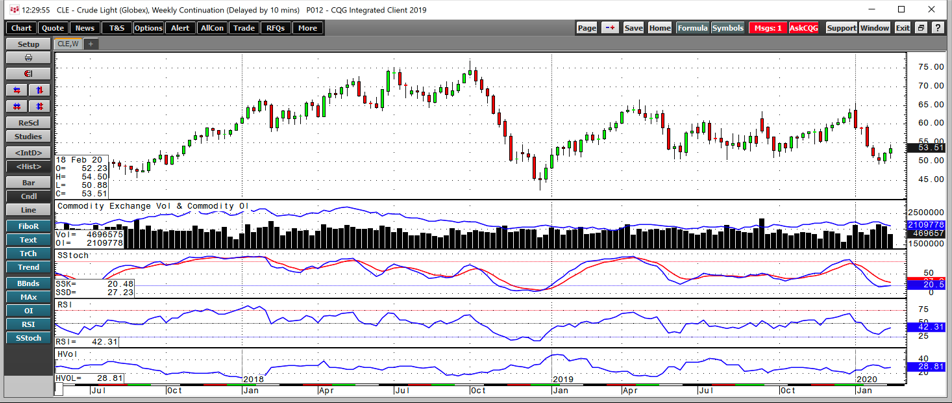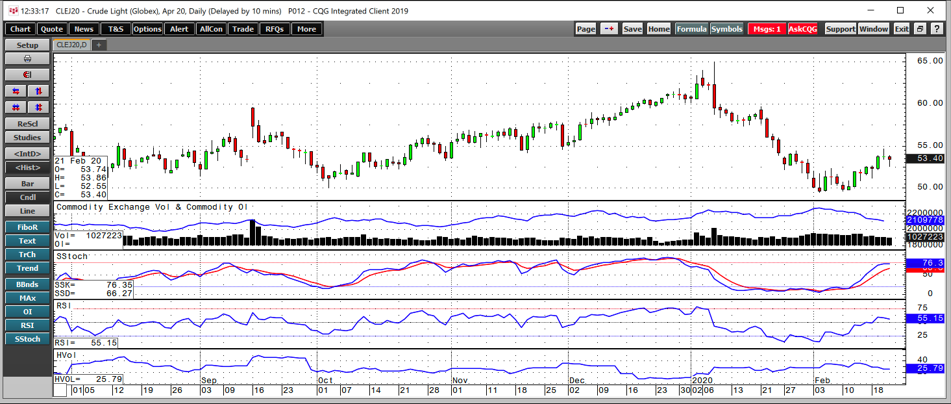- Crude oil probed below the $50 level and bounced
- February can be the weakest month of the year
OPEC on the horizon
Many markets across all asset classes have a habit of taking the stairs to the upside during bullish trends. Often, a bullish trend that lasts for months can lead to corrections that occur over short periods. Prices can take an elevator to the downside when a market runs out of buying. Historical volatility, the measure of price variance, often rises dramatically during corrective periods.
The stock market is a perfect example. The CBOE Volatility Index index measures the implied volatility of put and call options on the S&P 500 stocks. During bullish periods in the stock market, the VIX tends to move lower. When selling descends on the stock market, we often witness explosive moves in the volatility index.
Crude oil trades a lot like the stock market. Rallies can take months, while corrections often occur in a fraction of the time. Most recently, it took three months for the price of nearby NYMEX crude oil futures to rise from $50.99 per barrel in early October 2019 to a high of $65.65 in early January. It took only one short month to erase those gains as the energy commodity declined to a low of $49.31 per barrel on February 4.
Over the past two weeks, the crude oil market got off the elevator and back onto the stairs. The United States Oil Fund (NYSE:USO) replicates the price action in the nearby NYMEX crude oil futures contract on a short-term basis.
Crude Oil Probed Below $50 And Bounced
After five consecutive weeks of lower prices and losses in the crude oil futures market, the price finished last week with the second straight gain.
 Weekly Crude Oil
Weekly Crude Oil
(Source: CQG)
As the weekly chart shows, the price traded on either side of the $50 level from February 3 through February 12 but ran out of downside steam and rallied to a high of $54.50 last week. Price momentum remained in oversold territory at the end of last week, but relative strength turned higher and was approaching a neutral reading.
 Daily Crude Oil
Daily Crude Oil
(Source: CQG)
The daily chart of the now active April NYMEX futures illustrates that the total number of open long and short positions reached a peak of 2.272 million contracts on February 4 as crude oil was hitting its low. The decline to 2.11 million contracts at the end of last week was a warning sign for the oil market because rising price and falling open interest is not typically a technical validation of an emerging bullish trend in a futures market.
February Can Be The Weakest Month Of The Year
While the decline in open interest presents a technical concern for the price of crude oil as it attempts to move higher, February is coming to an end this week. February can be a time when crude oil makes significant bottoms as we witnessed in 2016 when the price fell to $26.05 per barrel and turned high in the months that followed.
Demand for gasoline tends to decline significantly during the winter months, which translated to falling demand for crude oil. As the spring season approaches, refineries tend to work overtime to refine crude oil into the fuel as drivers begin to put more miles on their odometers as the weather improves. Therefore, seasonality in the oil market provides some support for the price of the energy commodity as the weather begins to warm.
OPEC On The Horizon
At its late 2019 meeting, the international oil cartel cut production from 1.2 to 1.7 million barrels per day. Saudi Arabia threw in another 400,000-barrel reduction in output for good measure bringing the total amount of the production cut to 2.1 million. The oil ministers of OPEC agreed that they would meet in early March to assess the effectiveness of the current policy.
The sweet spot for the price of crude oil for the oil ministers is between the $60 and $70 per barrel level on nearby Brent futures.
(Source: Barchart)
As the chart shows, at the end of last week, the price of nearby April Brent futures was below the lower end of the cartel’s target range. The production cut was on the back of the ongoing trade war in late 2019. While the U.S. and China signed a “phase one” agreement de-escalating the conflict, the outbreak of coronavirus in China trumped trade as a threat to the global economy. OPEC will likely leave the output cuts in place or reduce daily production further if the price of oil slips lower, which is supportive of prices. At the same time, Iran remains a clear and present danger for Middle Eastern oil supplies. Any hostilities could cause price spikes to the upside, as we witnessed in mid-September 2019 and January 8, 2020.
The elevator ride in the crude oil futures market ended at just below $50 on nearby NYMEX futures. The energy commodity is back on the stairs to the upside. I would be a buyer on dips in the crude oil market.
The United States Oil Fund LP was trading at $10.61 per share on Tuesday morning, down $0.13 (-1.21%). Year-to-date, USO has declined -11.66%, versus a 20.51% rise in the benchmark S&P 500 index during the same period.
USO (NYSE:USO) currently has an ETF Daily News SMART Grade of A (Strong Buy), and is ranked #1 of 109 ETFs in the Commodity ETFs category.
